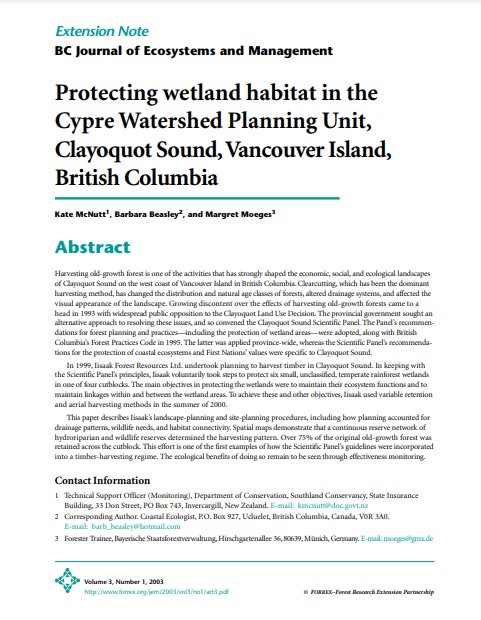Protecting wetland habitat in the Cypre Watershed Planning Unit, Clayoquot Sound, Vancouver Island, British Columbia
Bosque Modelo:
Long Beach
Temática:
Conservación
Tipo de documento:
Artículo científico
Resumen
Harvesting old-growth forest is one of the activities that has strongly shaped the economic, social, and ecological landscapes of Clayoquot Sound on the west coast of Vancouver Island in British Columbia. Clearcutting, which has been the dominant harvesting method, has changed the distribution and natural age classes of forests, altered drainage systems, and affected the visual appearance of the landscape. Growing discontent over the effects of harvesting old-growth forests came to a head in 1993 with widespread public opposition to the Clayoquot Land Use Decision. The provincial government sought an alternative approach to resolving these issues, and so convened the Clayoquot Sound Scientific Panel. The Panel’s recommendations for forest planning and practices—including the protection of wetland areas—were adopted, along with British Columbia’s Forest Practices Code in 1995. The latter was applied province-wide, whereas the Scientific Panel’s recommendations for the protection of coastal ecosystems and First Nations’ values were specific to Clayoquot Sound. In 1999, Iisaak Forest Resources Ltd. undertook planning to harvest timber in Clayoquot Sound. In keeping with the Scientific Panel’s principles, Iisaak voluntarily took steps to protect six small, unclassified, temperate rainforest wetlands in one of four cutblocks. The main objectives in protecting the wetlands were to maintain their ecosystem functions and to maintain linkages within and between the wetland areas. To achieve these and other objectives, Iisaak used variable retention and aerial harvesting methods in the summer of 2000. This paper describes Iisaak’s landscape-planning and site-planning procedures, including how planning accounted for drainage patterns, wildlife needs, and habitat connectivity. Spatial maps demonstrate that a continuous reserve network of hydroriparian and wildlife reserves determined the harvesting pattern. Over 75% of the original old-growth forest was retained across the cutblock. This effort is one of the first examples of how the Scientific Panel’s guidelines were incorporated into a timber-harvesting regime. The ecological benefits of doing so remain to be seen through effectiveness monitoring
Información Bibliográfica
Autor:
McNutt, K, B Beasley and M Moeges.
Revista:
BC Journal of Ecosystems and Management
Año:
2003
N°:
1
País :
Canadá
Páginas:
-
Volumen:
3
Idioma:
Ingles
Palabras claves
Model forest, Long beach, Canada





